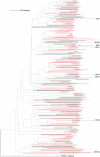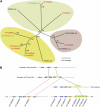Genome-wide comparison of nucleotide-binding site-leucine-rich repeat-encoding genes in Arabidopsis
- PMID: 21810963
- PMCID: PMC3192553
- DOI: 10.1104/pp.111.181990
Genome-wide comparison of nucleotide-binding site-leucine-rich repeat-encoding genes in Arabidopsis
Abstract
Plants, like animals, use several lines of defense against pathogen attack. Prominent among genes that confer disease resistance are those encoding nucleotide-binding site-leucine-rich repeat (NB-LRR) proteins. Likely due to selection pressures caused by pathogens, NB-LRR genes are the most variable gene family in plants, but there appear to be species-specific limits to the number of NB-LRR genes in a genome. Allelic diversity within an individual is also increased by obligatory outcrossing, which leads to genome-wide heterozygosity. In this study, we compared the NB-LRR gene complement of the selfer Arabidopsis thaliana and its outcrossing close relative Arabidopsis lyrata. We then complemented and contrasted the interspecific patterns with studies of NB-LRR diversity within A. thaliana. Three important insights are as follows: (1) that both species have similar numbers of NB-LRR genes; (2) that loci with single NB-LRR genes are less variable than tandem arrays; and (3) that presence-absence polymorphisms within A. thaliana are not strongly correlated with the presence or absence of orthologs in A. lyrata. Although A. thaliana individuals are mostly homozygous and thus potentially less likely to suffer from aberrant interaction of NB-LRR proteins with newly introduced alleles, the number of NB-LRR genes is similar to that in A. lyrata. In intraspecific and interspecific comparisons, NB-LRR genes are also more variable than receptor-like protein genes. Finally, in contrast to Drosophila, there is a clearly positive relationship between interspecific divergence and intraspecific polymorphisms.
Figures








Similar articles
-
Cell death mediated by the N-terminal domains of a unique and highly conserved class of NB-LRR protein.Mol Plant Microbe Interact. 2011 Aug;24(8):918-31. doi: 10.1094/MPMI-03-11-0050. Mol Plant Microbe Interact. 2011. PMID: 21501087
-
Uncovering the dynamic evolution of nucleotide-binding site-leucine-rich repeat (NBS-LRR) genes in Brassicaceae.J Integr Plant Biol. 2016 Feb;58(2):165-77. doi: 10.1111/jipb.12365. Epub 2015 Jul 24. J Integr Plant Biol. 2016. PMID: 25926337
-
Patterns of positive selection in the complete NBS-LRR gene family of Arabidopsis thaliana.Genome Res. 2002 Sep;12(9):1305-15. doi: 10.1101/gr.159402. Genome Res. 2002. PMID: 12213767 Free PMC article.
-
The Tomato Interspecific NB-LRR Gene Arsenal and Its Impact on Breeding Strategies.Genes (Basel). 2021 Jan 27;12(2):184. doi: 10.3390/genes12020184. Genes (Basel). 2021. PMID: 33514027 Free PMC article. Review.
-
NB-LRR proteins: pairs, pieces, perception, partners, and pathways.Curr Opin Plant Biol. 2010 Aug;13(4):472-7. doi: 10.1016/j.pbi.2010.04.007. Epub 2010 May 17. Curr Opin Plant Biol. 2010. PMID: 20483655 Free PMC article. Review.
Cited by
-
The Arabidopsis PHD-finger protein EDM2 has multiple roles in balancing NLR immune receptor gene expression.PLoS Genet. 2020 Sep 14;16(9):e1008993. doi: 10.1371/journal.pgen.1008993. eCollection 2020 Sep. PLoS Genet. 2020. PMID: 32925902 Free PMC article.
-
Evolution of the Rdr1 TNL-cluster in roses and other Rosaceous species.BMC Genomics. 2012 Aug 20;13:409. doi: 10.1186/1471-2164-13-409. BMC Genomics. 2012. PMID: 22905676 Free PMC article.
-
Arabidopsis thaliana DM2h (R8) within the Landsberg RPP1-like Resistance Locus Underlies Three Different Cases of EDS1-Conditioned Autoimmunity.PLoS Genet. 2016 Apr 15;12(4):e1005990. doi: 10.1371/journal.pgen.1005990. eCollection 2016 Apr. PLoS Genet. 2016. PMID: 27082651 Free PMC article.
-
Genome-wide analysis of NBS-LRR genes revealed contribution of disease resistance from Saccharum spontaneum to modern sugarcane cultivar.Front Plant Sci. 2023 Feb 20;14:1091567. doi: 10.3389/fpls.2023.1091567. eCollection 2023. Front Plant Sci. 2023. PMID: 36890898 Free PMC article.
-
The wheat homolog of putative nucleotide-binding site-leucine-rich repeat resistance gene TaRGA contributes to resistance against powdery mildew.Funct Integr Genomics. 2016 Mar;16(2):115-26. doi: 10.1007/s10142-015-0471-y. Epub 2016 Jan 27. Funct Integr Genomics. 2016. PMID: 26815536
References
-
- Akita M, Valkonen JP. (2002) A novel gene family in moss (Physcomitrella patens) shows sequence homology and a phylogenetic relationship with the TIR-NBS class of plant disease resistance genes. J Mol Evol 55: 595–605 - PubMed
-
- Allen RL, Bittner-Eddy PD, Grenville-Briggs LJ, Meitz JC, Rehmany AP, Rose LE, Beynon JL. (2004) Host-parasite coevolutionary conflict between Arabidopsis and downy mildew. Science 306: 1957–1960 - PubMed
Publication types
MeSH terms
Substances
LinkOut - more resources
Full Text Sources
Molecular Biology Databases

